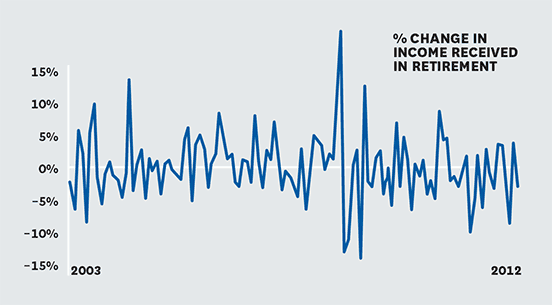Portfolios Changes In Retirement guidelines for important strategy decisions
Post on: 2 Июнь, 2015 No Comment

Portfolio Changes in Retirement
Jack Piazza
R etirement. the ultimate goal. For most people, retirement not only brings a change in lifestyle, it also necessitates a major change in their mutual fund portfolio. In retirement, the vast majority of investors must switch gears from asset accumulation to asset withdrawal — this fundamental change requires (1) an assessment of income needed for a desired lifestyle and (2) a re-evaluation of portfolio return objectives and risk tolerance.
Ideally, an effective retirement strategy should provide adequate income to last over an individual’s remaining life span, cash for emergencies and sufficient growth to protect assets against asset erosion. The three major challenges facing retirees: (1) creating an appropriate allocation strategy that addresses realistic withdrawal rates for income, (2) estimating the amount of money needed for emergencies and (3) including sufficient growth in the portfolio to protect against rapid portfolio asset depletion. Let’s review these factors.
Amount of Income Needed
First estimate annual living expenses for retirement. Then figure how much pre-tax income is needed in retirement. One general rule has been to estimate retirement expenses at 70-80% of pre -retirement income, but many individuals pick up additional expenses in retirement such as increased travel, club memberships, etc. To be precise, it is best to itemize current expenses, then add or subtract for expense adjustments as needed.
To calculate a pre-tax number, divide retirement expenses by one minus your tax bracket. Once you have the pre-tax income estimate, figure the income that would be needed from your mutual fund portfolio, after subtracting distributions from social security, pensions and any other sources of income (individual stocks, limited partnerships, etc). Reminder: withdrawals from tax-deferred accounts (401K, traditional IRA, etc.) are treated as taxable income.
Special Note: High income earners should consider the ramifications of future tax rates. For example, Health Care legislation became law in early 2010 which imposes a 3.8% Medicare surtax on income exceeding $200,000 for individuals, or $250,000 for joint filers — beginning in 2013 . This surtax will be assessed on the lower of (1) Net Investment Income, or (2) Modified Adjusted Gross Income (MAGI) in excess of the income thresholds for single or joint filers.
Net investment income for the purposes of calculating the unearned income Medicare contribution tax includes interest, dividends, capital gains, annuities, royalties, rents, and pass-through income from passive businesses. The following types of income will not be subject to this additional Medicare tax : tax-exempt municipal bond interest, nontaxable veteran’s benefits, capital gains excluded from the sale of a principal residence, and distributions from traditional and Roth IRAs, 403(b) plans, 401(k) plans, 457 plans, pensions and profit-sharing plans.
- Case A. a single flier or a couple filing jointly exceeds MAGI thresholds with zero net investment income. No Medicare surtax is due (zero net investment income x 3.8% = zero).
Emergencies
After figuring annual pre-tax income, determine the amount of money needed for emergencies. In pre-retirement, the standard rule of thumb was to keep three to six months of living expenses in a money market fund (or equivalent); the reasoning for this is to assure that long-term growth-oriented strategies could continue uninterrupted. However, to account for unexpected expenses (medical costs, home repair, etc) or market downturns in retirement, you may want to allocate up to twelve months of living expenses in a money market fund, an ultra short-term bond fund and/or a short-term treasury bond fund. Note: many retirees may have adequate emergency funds which would cover six months of living expenses — the actual number of months covered in an emergency fund will vary due to an investors comfort level and individual circumstances.
Some advisers recommend allocating up to 10% of assets for this purpose in a long-term, income-oriented portfolio — however, if your time horizon is less than five years, then you may feel more comfortable with a larger percentage (e.g. 15-20%) in a combination of a money market fund and a short-term government bond fund for emergencies. However, the size of your portfolio, along with up to twelve months of estimated expenses, should be the determining factor rather than a percentage guideline.
Sufficient Growth in Portfolio
Once pre-tax income and emergencies amounts have been determined, the next step is to address what role growth has in your retirement portfolio. Exactly how much allocation in growth depends upon the asset size of your portfolio and amount of income needed. Depending upon the size of assets, the purpose of growth in a retirement portfolio may be several fold:
Protection against inflation erosion of assets. Assuming a historical 3% inflation rate, an income of $40,000 today would need an income of approximately $72,250 in twenty years to retain current purchasing power. Unless your portfolio had sufficient growth to offset this effect of inflation, you would be forced to either (1) withdraw assets at a much higher rate than portfolio earnings, which would shorten portfolio life — e.g. withdrawing 10% when the portfolio earns 8% or (2) significantly lower your standard of living — which would be undesirable for most retirees.
Protection against a depleting portfolio. If withdrawal rates exceed portfolio earning rates, portfolio life is shortened. Excluding the effect of inflation and taxes, if you withdraw 10% a year from a portfolio earning 6% annually, your assets will be fully depleted in 15 years; in the above example where annual withdrawal is 12% verses 6% annual earnings, the portfolio would be fully depleted in just 11.4 years. When withdrawal rates are greater than earning rates, sufficient portfolio growth is needed to help extend assets over life expectancy.
The following tables illustrate various withdrawal rates and the number of years a portfolio would last. Note: these examples exclude the effect of taxes and inflation , both of which would significantly shorten the portfolio life in these examples .
Portfolio Earning 4% per Year














